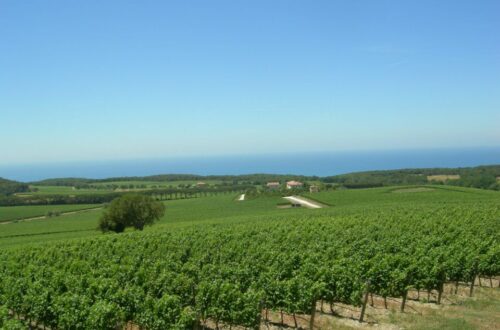Vin Santo di Montepulciano DOC represents one of Tuscany’s most coveted dessert wines, crafted in extremely limited quantities from ancient Italian sweet wine traditions. With its burnished amber hue, honeyed aromas, and meditative depth, it’s more than a drink—it’s a ritual, a story, and a treasure from Montepulciano’s hilltop vineyards.
Table of Contents
What is Vin Santo di Montepulciano DOC?
A Tuscan dessert wine steeped in tradition, Vin Santo di Montepulciano DOC is produced in minuscule volumes—often under 1,200 cases annually. It is made using the appassimento method, where grapes dry slowly before pressing, concentrating their sugars and flavors into a luscious golden nectar.
History and Origins
Recognized as a DOC in 1996, Vin Santo di Montepulciano traces its roots to medieval Tuscany, where it was often reserved for special celebrations and Mass. Families guarded their “mother yeast” and passed it down through generations, ensuring a continuity of flavor and tradition.
Where It’s Made: Geography and Terroir
Montepulciano’s vineyards rest at 250–600 meters elevation, on sandy-clay and tuffaceous soils, benefiting from sunny days and cool nights. The result is grapes with both rich sugar content and refreshing acidity—perfect for dessert wine.
The Grape (or Blend)
Vin Santo di Montepulciano DOC: Minimum 70% Grechetto, Malvasia Bianca Lunga, Trebbiano Toscano
Occhio di Pernice: Minimum 50% Sangiovese (Prugnolo Gentile) for a rosé-amber hue
Winemaking and DOC Regulations
Grapes dried until 280–330 grams per liter sugar before pressing
Pressing not before December 1 for Vin Santo and January 1 for Riserva and Occhio di Pernice
Aging 3–6 years in small caratelli barrels
Minimum alcohol: 12–21% depending on style
Key Facts at a Glance
DOC Since: 1996
Vineyard Area: 5 hectares
Production: Approximately 100 hectoliters per year
Styles: Vin Santo, Riserva, Occhio di Pernice
Aging: 3–6 years
Grapes: Grechetto, Malvasia Bianca Lunga, Trebbiano Toscano, Sangiovese
Serving Temperature: 12–15°C
Tasting Notes
Amber-gold color; aromas of dried apricot, honey, almond, and candied orange. On the palate: velvety sweetness balanced by acidity, with caramel and toasted nut undertones.
Serving and Pairing
Serve at 12–15°C in a tulip glass. Traditionally enjoyed with cantucci biscuits, but also ideal with aged blue cheeses, foie gras, and dark chocolate.
Best Food Pairings with Vin Santo
Sweet: Almond biscotti, fig tart, ricciarelli
Savory: Aged pecorino, foie gras terrine
Fruit-based: Poached pears, orange panna cotta
Vin Santo di Montepulciano vs Other Italian Dessert Wines
Compared to Vin Santo del Chianti Classico, Montepulciano’s version is rarer, smaller in production, and often more oxidative in style with deeper nutty notes.
Best Vin Santo di Montepulciano Producers
Boscarelli – Elegant and complex, aged over six years
Cantine Dei – Almond and apricot-driven style
Fattoria del Cerro – Balanced sweetness and freshness
Vin Santo Price Guide by Vintage
2016: €35–40 (375ml)
2010 Riserva: €60–80
Occhio di Pernice: €70–100
How to Store Vin Santo
Store bottles upright in a cool, dark place. Once opened, Vin Santo can remain fresh for weeks due to its high sugar and alcohol content.
Where to Buy
Available at specialty wine retailers, Italian gourmet shops, and online stores like Eataly, Vinitaly Wine Club, and Wine.com.
Visiting Montepulciano for Vin Santo Tastings
Combine your tasting with a tour of Montepulciano’s medieval cellars, many of which also produce the famous Vino Nobile di Montepulciano DOCG.
FAQ on Vin Santo di Montepulciano DOC
Is it always sweet? Yes, though sweetness varies by producer.
Can it age? Yes, for decades in the right conditions.
Best time to drink? After meals or with dessert.
Fun Facts and Cultural Notes
“Vin Santo” means “holy wine,” likely due to its historic use in religious rites.
Tuscan families traditionally serve it to guests as a symbol of hospitality.
CTA for Audience Engagement
Have you ever sipped Vin Santo di Montepulciano in its Tuscan homeland? Share your tasting memories in the comments, and tag us on Instagram with #DrinkItalian for a chance to be featured.


